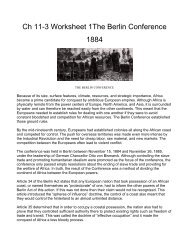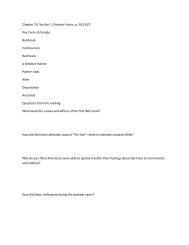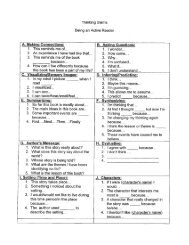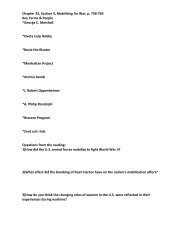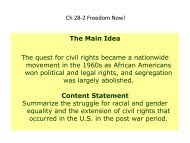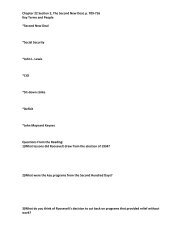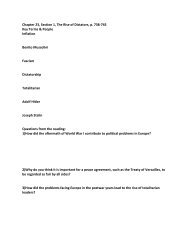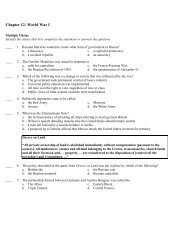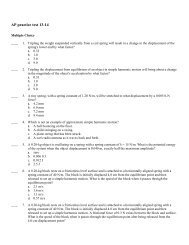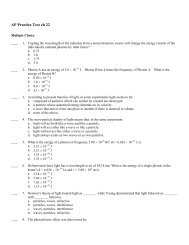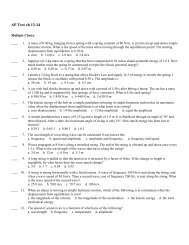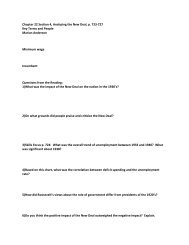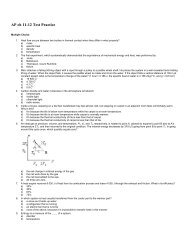From Rural to Urban America - Geneva Area City Schools
From Rural to Urban America - Geneva Area City Schools
From Rural to Urban America - Geneva Area City Schools
You also want an ePaper? Increase the reach of your titles
YUMPU automatically turns print PDFs into web optimized ePapers that Google loves.
Name _____________________________ Class _________________ Date __________________<br />
The Roaring Twenties<br />
His<strong>to</strong>ry and Geography<br />
<strong>From</strong> <strong>Rural</strong> <strong>to</strong> <strong>Urban</strong> <strong>America</strong><br />
In the shift from rural <strong>America</strong> <strong>to</strong> urban <strong>America</strong>, 1920 was a significant<br />
year. It was the first year in which the percentage of people living in urban<br />
areas (51.4 percent) was greater than the percentage of people living in<br />
rural areas. The table below gives urban population percentages for the<br />
United States in 1920. Use the information <strong>to</strong> complete the map activity<br />
and answer the questions on the following page.<br />
State<br />
<strong>Urban</strong> Population of the United States, 1920<br />
Percent<br />
<strong>Urban</strong><br />
State<br />
Percent<br />
<strong>Urban</strong><br />
State<br />
Percent<br />
<strong>Urban</strong><br />
Alabama 21.7 Maine 39.0 Ohio 63.8<br />
Arizona 35.2 Maryland 60.0 Oklahoma 26.6<br />
Arkansas 16.6 Massachusetts 94.8 Oregon 49.9<br />
California 68.0 Michigan 61.1 Pennsylvania 64.3<br />
Colorado 48.2 Minnesota 44.1 Rhode Island 97.5<br />
Connecticut 67.8 Mississippi 13.4 South Carolina 17.5<br />
Delaware 54.2 Missouri 46.6 South Dakota 16.0<br />
Florida 36.7 Montana 31.3 Tennessee 26.1<br />
Georgia 25.1 Nebraska 31.3 Texas 32.4<br />
Idaho 27.6 Nevada 19.7 Utah 48.0<br />
Illinois 67.9 New Hampshire 63.1 Vermont 31.2<br />
Indiana 50.6 New Jersey 78.4 Virginia 29.2<br />
Iowa 36.4 New Mexico 18.0 Washing<strong>to</strong>n 55.2<br />
Kansas 34.9 New York 82.7 West Virginia 25.2<br />
Kentucky 26.2 North Carolina 19.2 Wisconsin 47.3<br />
Louisiana 34.9 North Dakota 13.6 Wyoming 29.5<br />
Source: Statistical Abstract of the United States: 1941<br />
MAP ACTIVITY<br />
1. With a highlighter or pen, fill in the box next <strong>to</strong> “Greater urban population” in the<br />
map’s key. Use the same highlighter or pen <strong>to</strong> shade or underline the states on the<br />
map whose urban populations are greater than their rural populations, as indicated in<br />
the table.<br />
2. Use a second highlighter or pen <strong>to</strong> fill in the box next <strong>to</strong> “Greater rural population” in<br />
the map’s key. Use the same highlighter or pen <strong>to</strong> shade or underline the states on the<br />
map whose rural populations are greater than their urban populations, as indicated in<br />
the table.<br />
Copyright © by Holt, Rinehart and Wins<strong>to</strong>n. All rights reserved.<br />
16 The Roaring Twenties
Name _____________________________ Class _________________ Date __________________<br />
The Roaring Twenties<br />
His<strong>to</strong>ry and Geography<br />
ANALYZING MAPS<br />
1. Rank Based on the table, which state had the highest percentage of urban residents<br />
in 1920? Which state had the highest percentage of rural residents in 1920?<br />
____________________________________________________________________<br />
____________________________________________________________________<br />
2. Region As far as urban versus rural, how would you characterize the 1920<br />
population of the New England region, which includes Maine, New Hampshire,<br />
Vermont, Massachusetts, Rhode Island, and Connecticut?<br />
____________________________________________________________________<br />
3. Region As far as urban versus rural, how would you characterize the 1920<br />
population of the South Central region, which includes Arkansas, Louisiana,<br />
Oklahoma, Texas, Kentucky, Tennessee, Alabama, and Mississippi?<br />
____________________________________________________________________<br />
4. Make Inferences In 1920 there were more than twice as many states with greater<br />
rural populations than urban populations, yet the <strong>to</strong>tal population of the United States<br />
was more urban than rural. How can you explain this apparent discrepancy?<br />
____________________________________________________________________<br />
____________________________________________________________________<br />
____________________________________________________________________<br />
____________________________________________________________________<br />
Copyright © by Holt, Rinehart and Wins<strong>to</strong>n. All rights reserved.<br />
17 The Roaring Twenties



